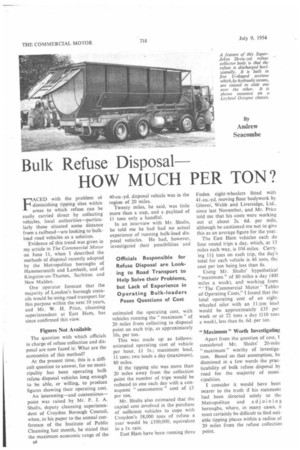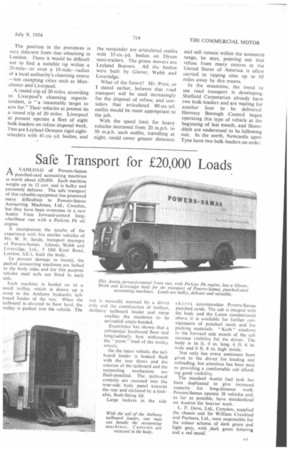Bulk Refuse Disposal HOW MUCH PER TON?
Page 42

Page 43

If you've noticed an error in this article please click here to report it so we can fix it.
By
Andrew Seacombe
FACED with the problem of diminishing tipping sites within areas to which refuse can be easily carried direct by collecting vehicles, local authorities—particularly those situated some distance from a railhead—are looking to bulkload road vehicles as a solution.
Evidence of this trend was given in my article in The Commercial Motor on June 11, when I described the methods of disposal recently adopted by the Metropolitan boroughs of Hammersmith and Lambeth, and of Kingston-on-Thames, Surbiton and New Malden.
One operator forecast that the majority of London's borough councils would be using road transport for this purpose within the next 10 years, and Mr. W. H. Price, cleansing superintendent at East Ham, has since confirmed this view.
Figures Not Available The question with which officials in charge of refuse collection and disposal are now faced is: What are the economics of this method?
At the present time, this is a difficult question to answer, for no municipality has been operating bulk refuse disposal vehicles long enough to be able, or willing, to produce figures showing their operating cost.
An interesting—and contentious— point was raised by Mr. F. J. A. Shults, deputy cleansing superintendent of Croydon Borough Council, when, in his paper to the annual conference of the Institute of Public Cleansing last month, he stated that the maximum economic range of the a8 40-cu.-yd. disposal vehicle was in the region of 20 miles.
Twenty miles, he said, was little more than a step, and a payload of 11 tons only a handful.
In an interview with Mr. Shults, he told me he had had no actual experience of running bulk-load disposal vehicles. He had, however, investigated their possibilities and estimated the operating cost, with vehicles running the " maximum " of 20 miles from collecting to disposal point on each trip, as approximately 10s. per ton.
This was made up as follows: estimated operating cost of vehicle per hour, 5s.; maximum load, 11 tons; two loads a day (maximum), 80 miles.
If the tipping site was more than 20 miles away from the collection point the number of trips would be reduced to one each day with a consequent " uneconomic" cost of £1 per ton.
Mr. Shults also estimated that the capital cost involved in the purchase of sufficient vehicles to cope with Croydon's 58,000 tons of refuse a year would be £100,000, equivalent to a Is. rate.
East Ham have been running three Foden eight-wheelers fitted with 41-cu.-yd. moving floor bodywork by Glover, Webb and Liversidge, Ltd., since last November, and Mr. Price told me that his costs were working out at about 2s. 6d. per mile, although he cautioned me not to give this as an average figure for the year.
The East Ham vehicles each do four round trips a day, which, at 13 miles each way, is 104 miles. Carrying ll tons on each trip, the day's total for each vehicle is 46 tons, the cost per ton being less than 6s.
Using Mr. Shults' hypothetical " maximum " of 80 miles a day (400 miles a week), and working from " ' The Commercial Motor' Tables of Operating Costs," I found that the total operating cost of an eightwheeled oiler with an 11-ton load would be approximately £35 per week or at 22 tons a day (110 tons a week), less than 6s. 6d. per ton.
"Maximum" Worth Investigating Apart from the question of cost, I considered Mr. Shults' 20-mile " maximum " worthy of investigation. Based on that assumption, he dismissed in a few words the practicability of bulk refuse disposal by road for the majority of municipalities.
I consider it would have been nearer to the truth if his statement had been directed solely to the Metropolitan and adjoining boroughs, where, in many cases, it must certainly be difficult to find suitable tipping places within a radius of 20 miles from the refuse collection point. The position in the provinces is very different from that obtaining in London. There it would be difficult not to find a suitable tip within a -20-mile—or even a 10-mile--radius of a local authority's cleansing centre —not excepting cities such as Manchester and Liverpool.
A round trip of 20 miles, according to Liverpool's cleansing superintendent, is "a reasonable target to aim for." Their vehicles at present do a round trip of 20 miles. Liverpool at present operate a fleet of eight bulk-loaders on refuse disposal work. Two are Leyland Octopus rigid eightwheelers with 41-cu.-yd. bodies, and the remainder are articulated outfits with 35-cu.-yd. bodies on Dyson semi-trailers. The prime movers are Leyland Beavers. All the bodies were built by Glover, Webb and Liversidge.
What.of the future? Mr. Price, as I stated earlier, believes that road transport will be used increasingly for the disposal of refuse, and considers that articulated 80-cu.-yd. outfits would be more appropriate to the job_
With the speed limit for heavy vehicles increased from 20 m.p.h. to 30 m.p.h. such outfits, travelling at night, could cover greater distances and still remain within the economic range, he says, pointing out that refuse from many centres in the United States of America is often carried to tipping sites up to 60 miles away by this means.
In the meantime, the trend to use road transport is developing. Sheffield Corporation already have two bulk-loaders and are waiting for another four to be delivered. Hornsey Borough Council began operating this type of vehicle at the beginning of last month, and Shoreditch are understood to be following suit. In the north, Newcastle upon Tyne have two bulk-loaders on order.




























































































